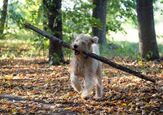Are Wood Chews Safe for Dogs?

We all know that dogs have a natural desire to chew. However, with the growing awareness of the risks of the old faithful rawhide bone, dog parents are searching for a safe alternative. One popular solution is the wood chew; after all, dogs chew sticks. Right? But are these actually a safe choice?
It’s crucial to understand that not all wood chews are created equal. While some do offer mental enrichment and other benefits, others can pose serious health risks.
In this article, I will walk through the most common types of wood chews available, their potential benefits, and the possible risks of giving them to your pup. I’ll also offer tips on choosing the best wood chew for your dog and other chew options to consider.
By the end, you’ll have the information you need to make the best possible choice for your best friend!
Why is Chewing Important for Dogs?
Chewing is a natural and deeply ingrained behavior in our dogs, dating back to their wild ancestors. It serves several important purposes, both physical and mental. It’s a natural outlet for dogs to explore their environment, which any puppy owner can attest to. It’s also a great tool for managing stress and anxiety and alleviating boredom.
Of course, as any puppy parent can attest, chewing behaviors can be directed toward inappropriate things. If you’ve ever had your puppy chew up your favorite shoes, you know what I’m talking about!
As dog parents, the best thing we can do is offer safe and engaging chew toys to satisfy their desire to chew. There are several different chew toy options to consider, including treat-style chews, hard rubber toys, rope toys, nylon chews, and more. However, one option that has been drawing a lot of attention lately is the wood chew.
Benefits of Wood Chews for Your Dog
So, why are wood chews so common? These seemingly simple dog chews actually offer many great benefits for our dogs. From giving them a safe outlet for their natural instincts to helping improve their overall dental health. Here are a few benefits to consider:
Help with Puppy Chewing
As mentioned, puppies have a strong desire to chew. This is for several reasons – they are exploring the world around them with their mouths, they have a natural drive to chew, and, at certain stages in their development, they are teething. For these reasons, expecting a puppy simply not to chew is unreasonable. But you can set your puppy up for success!
Giving a puppy safe and appropriate chewing options is the best way to stop destructive behaviors (combined with proper puppy-proofing). If you notice your puppy chewing on something they shouldn’t, swap the item for a wood chew to help teach them where to direct these urges.
Relieve Boredom
Boredom is the root of most destructive behaviors in dogs. When experiencing pent-up energy and no suitable outlet, dogs often turn to chewing, digging, and destroying things around the house. It can also contribute to stress, anxiety, and reactivity. Many experts even point to boredom as one of the most serious problems faced by dogs in today’s day and age.
A safe chew, like a wood chew, is a great way to offer entertainment and mental enrichment, even if you’re dealing with a busy schedule. Find options that your dog enjoys and rotate to keep things interesting.
Reduce Stress and Anxiety
When a dog is chewing, the action releases endorphins, which help create a feeling of calm and happiness. This makes it a great option for helping dogs relax and work through challenging situations like separation anxiety. Providing a chew is also a great distraction if you have guests over or as part of a bigger relaxation plan during triggering experiences like fireworks or thunderstorms.
Improve Dental Health
It is estimated that over 80% of all dogs three and older will have active dental disease. The stat is disturbing! As pet parents, that leaves many of us looking for ways to improve our dog’s dental health and prevent problems from developing. While wood chews shouldn’t be seen as a substitute for proper dental cleanings, they are a great addition to your dental care plan!
As your dog chews, the texture of a wood chew scrapes at the teeth, removing plaque and tartar buildup. The chew also massages the gums, which can help increase blood flow to the area and encourage healthy gums.
Build Jaw Strength
Another benefit that is often overlooked is the way that chewing will help to build jaw strength. This is a natural benefit that your dog’s wild ancestors relied on and one we should consider, too.
Dogs with weakened jaw can struggle with several complications, including:
- Excessive drooling
- Difficulty eating or messy eating
- Trouble chewing their food
- Inability to close their mouth
Obviously, when a dog is having a hard time eating, that can significantly impact their health and well-being. If your dog cannot get the nutrition they need, it can cause long-term health complications and even lead to life-threatening problems in the more severe cases.
Avoid Food Allergies or Sensitivities
If you have a dog dealing with food allergies or sensitivities, trying to find treats and chews can be challenging. Having cared for dogs with allergies before, it’s a struggle I understand all too well. One of the benefits of offering your dog a high-quality wood chew is that you don’t have to be worried about hidden ingredients or what food items your dog is allergic to – it’s a safe option.
Keep Even Heavy Chewers Happy
We have all met at least one of these dogs in our lives – the dogs that can tear through anything and everything, including the many toys that have been labeled as “indestructible.” Trying to find something that will last longer than 10 minutes can seem impossible. Luckily, some wood chews are made from a harder, more durable wood, making them a longer-lasting option even for power chewers.
Common Types of Wood Chews
Wood chews come in many different forms, each with its own benefits, like varying degrees of hardness and durability. If you have a heavy chewer, you understand just how important those factors can be! Meanwhile, other types of wood are softer for dogs who need a gentler chew, like senior pups and those with dental issues.
When shopping for a new chew, some common types you may see include:
- Coffee wood
- Olive wood
- Briar root
- European tree heath
In addition to the different types of wood, these chews also come in different forms or appearances. Root chews have an irregular rock-like shape. This is because they are just pieces of the larger root of a tree. Other chews have a smoother stick-like appearance, making them easy to hold.
Finally, some companies create more aesthetic or creative wood chews by carving the wood into fun designs. For example, you may find a wood chew that looks like an oversized pinecone, a fish, or the traditional dog bone shape.
How to Choose the Best Wood Chew for Your Dog
Here are a few important factors to consider when shopping for the best wood chew for your dog:
- Size: These chews come in various sizes and shapes. You should aim to find one large enough to prevent choking while still being small enough for your dog to hold and chew on it comfortably.
- Hard vs. Soft: Consider your dog’s chewing habits, dental health, and age when deciding the hardness. A power chewer will benefit from the most durable woods, while a young puppy, senior dog, or one with dental issues may need something softer.
- Brands/Suppliers: Make sure you are looking for brands that prioritize quality products and your pup's safety. You may save a little with a cheaper product, but in doing so, you risk giving your dog a product that could be unsafe or even contain toxic materials.
In addition to choosing the right chew, there are a few other steps you should take to let your dog enjoy their new chew safely. Always supervise them when chewing. Even with the most carefully chosen products, accidents happen. For example, if a piece breaks off the chew, it could create a choking hazard that needs to be addressed immediately to save your dog’s life!
Regularly check your dog’s chew for signs of wear and tear. If you notice rough, sharp edges or splinters forming, you can sand it down to make it safe to continue chewing. It's time for a replacement when it has worn down too far.
Always have plenty of fresh, clean water available and accessible for your dog when chewing any chew or toy.
Our Go-To Wood Chew: Canophera Coffee Wood Chews
As you can see in the above picture, my little guy Lucifer loves his wood chews. Our go-to chew is the Canophera Coffee Wood Dog Chew Sticks. In the picture, he is holding a medium-sized coffee wood chew stick.
I first learned about the brand when attending Global Pet Expo 2024. After talking with representatives from Canophera, as well as some other trusted friends and connections in the pet industry, I decided that we would give them a try. Lucifer tends to destroy any chews or toys we bring home, so I wasn’t holding my breath on how long it would take.
The chews are made from coffee wood, a durable and long-lasting material. However, as a dog chews, the wood flakes off in fine fibers instead of slivers or chunks, like you would see with many other products. These small flakes are digestible, significantly reducing the risk of trouble caused by choking or gastrointestinal obstructions.
While he eventually destroyed the first wood chew, we have since replaced it. Given the time it took for him to work it down to the point of needing to be replaced, it was well worth the investment!
Final Thoughts: Wood Chews and Your Dog
While chewing is a necessary evil for our pups, there are ways to allow your dog to fulfill this desire without destroying your favorite shoes or the leg of your dining room table. Wood chews offer many benefits, including improving dental health, easing boredom, and reducing anxiety. They are a great option for dogs with food allergies or sensitivities as they contain only the specified type of wood (such as coffee wood or olive wood). They are also a great choice for power chewers due to their durability.
However, they are not without their risks. Ensure you are giving your dog the right chew for their needs, including the correct size and hardness level. Always supervise your dog when they are chewing. Inspect it regularly for signs of wear and tear, sanding it down to extend its life and replacing it when necessary.
With a little care and attention, wood chews are a safe, healthy, natural way to fulfill your dog’s chewing desires, keeping them happy and occupied.
Join the PetGuide community. Get the latest pet news and product recommendations by subscribing to our newsletter here.

Britt Kascjak is a proud pet mom, sharing her heart (and her home) with her “pack” which includes her husband John, their 2 dogs – Lucifer and Willow – and their 3 cats – Pippen, Jinx, and Theia. She has been active in the animal rescue community for over 15 years, volunteering, fostering and advocating for organizations across Canada and the US. In her free time, she enjoys traveling around the country camping, hiking, and canoeing with her pets.
More by Britt
























